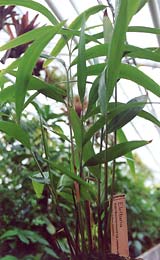

Cardamom (Elettaria Cardamomum)
Folk Names: Ailum, Alpinia Cardamomum, Amomum Cardamomum, Amomum repens, Bastard Cardamom, Capalaga, Cardamom Seeds, Cardamomi Semina, Cardamon, Cardamomum minus, Ebil, Gujatatti elachi, Ilachi, Kekelah seghar, Malabar Cardamoms, Matonia Cardamomum
Description: Cardamom is a perennial shrub related to ginger and found in southern India and tropical areas. The simple, erect stem grows from six to ten feet from a thumb-thick, creeping root. The leaves are alternate and lanceolate, dark green and glabrous above, lighter and silky beneath. Small flowers with red streaks and yellow tips appear in loose racemes on prostrate flower stems. These flower stems may be from a few inches to two feet long. The three-celled seed capsule produces up to eighteen seeds.
Effects: gentle
Planet: Venus
Element: water
Associated Deities: Erzulie
Traditions:
Cardamom is one of the oldest and highly valued spices in the world; it is the most expensive after saffron and vanilla. The Normans brought this spice to Britain in the eleventh century, and it was very popular in Tudor and medieval cuisine.
The Arabs gave cardamom coffee to visitors as a symbol of hospitality and to induce tranquil thought. It was the tradition that the ritual of coffee not be disturbed by business and negotiations not entered into until finished. The perfect guest might accept up to three cups.
Magic:
In addition to being an herb of peace and hospitality, the Arabs considered cardamom an aphrodisiac. The ground seed may be added to wine and to apple pie for lust. Love incense and sachets would also benefit from its addition.
Cardamom is also added to incense designed to drive off demons.
Known Combinations:
none known
Medical Indications: Parts Used: seeds
Cardamom is an appetizer, carminative, and stimulant. The Roman sage Apicius suggested cardamom for over indulgence. The seeds also remedy flatulence, but it is usually used in addition to other remedies. It is considered an effective remedy for lactose allergies however.
According to Ayurvedic medicine, cardamom is a cure for urinary complications, for removing fats from the body, for piles, and for jaundice. It is also suggested for halitosis, nausea, headache, fever, and applied topically to sooth eye disease.
Nutrition:
The taste of cardamom is slightly lemony and bitter sweet. The whole seed pods may be found in curries, pickled herring, hot punches, spiced wines, marinades, and various pickling liquids. The ground seeds are added to bread, pastries, cookies, fruit salads and other stewed fruits, rice pudding, and custards. It is found in Danish pastries, gingerbread, and coffee cakes. Cardamom is a very popular herb in Mexican, Spanish, and East Indian dishes. The spice is also used to flavor beef, pork, goose, and sausage.
Gahwa (cardamom coffee) is made with roasted green coffee beans. The beans are crushed with a brass mortar and pestle. The ground beans are then put into small brass coffee maker with hot water, broken cardamom pods, seeds, sugar, and a pinch of ground cloves. The coffee is boiled two to three minutes, strained, and served black, usually with small, sweet pastries.
Mercantile Uses:
Cardamom is used in potpourris and breath fresheners.
The best cardamom comes from the rain forests of Malabar, but it grows wild throughout the tropical mountain forests of India. It is cultivated in Sri Lanka and Thailand, as well as Central America.